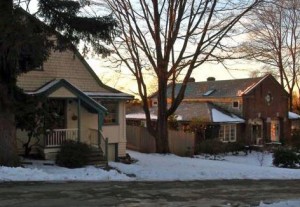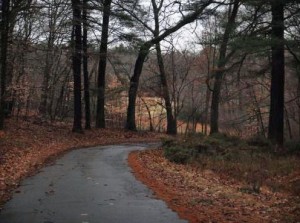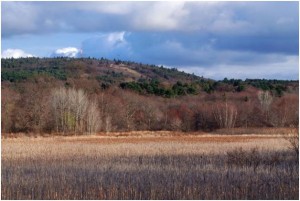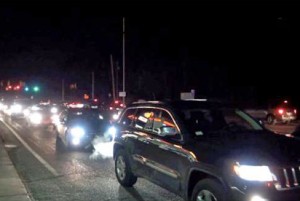The price of development ~ Part 2
By GuestMilton doesn’t have an affordable housing plan in effect yet and the town doesn’t have the state-required 10 percent quota of affordable housing. So, pursuant to rules that pertain to 40B projects, this project could be fast-tracked past the town’s planning board, past the zoning board, and even the Milton selectmen may not have a voice in curbing or stopping it. The proposed project includes a few acres in Canton, so their local boards may be able to weigh in on this development as Canton does meet the 10 percent quota for affordable housing.
But getting back to the neighborhood. You may not know this if you strolled down the winding road that feels like a step back in time, but it is not an old cow-path that simply got paved over.
Hemenway Drive was thoughtfully designed by a protégé of the man considered to be the father of American landscape architecture, Frederick Law Olmstead. The protégé was Arthur Shurtleff, who became famous in his own right for landscape design and urban planning in the Boston area.
Shurtleff was known for taking the beauty of nature into account. So, for example, one bend of the road deliberately peaks through a gap in the trees to overlook the Cumming’s meadow that has been framed by the conservation tree line across the field for more than a hundred years.
The buildings in this area are historic too. In the photo below you can see what the Hemenway residents call the “Button” (on the left) where Augustus and his peers are said to have played poker, and the “clock house” (on the right), which started out as a firehouse. The nearby dairy, mechanical repair barn, horse and cow barns are all still in the same place and surrounded by similar landscape. The structures have all been transformed into quaint homes while the shared road and open space have been preserved by the 14 families that live on Hemenway. The Hemenway documents preserving the neighborhood have all been honored from one generation to the next and from one homeowner to the next.
 My next-door neighbor, Win Burr, who is co-president of the Hemenway Drive Association, once said, “I feel like I am the caretaker of this special place for as long as I can be and then it will be the next person’s turn.”
My next-door neighbor, Win Burr, who is co-president of the Hemenway Drive Association, once said, “I feel like I am the caretaker of this special place for as long as I can be and then it will be the next person’s turn.”
In the early seventies, Hope Hemenway Richardson and Hope Richardson, the daughter and granddaughter of Hemenway Jr., were involved in stopping the Southwest Expressway from being built over Fowl Meadows. The Hemenway descendants along with many others convinced then Massachusetts Governor Sargent that the Fowl Meadows was worth preserving. Sargent described this area as a “major water resource, wildlife sanctuary and recreational open space facility” as he announced the cancelling of the project. Personal accounts from the time say that the environmental arguments got the ear of the governor and the Mass DPW and swayed them somewhat, but the tipping point that nixed the highway project was probably the high level of fog from the surrounding wetlands. Fog would be a safety issue for drivers on the proposed highway.
This was a large lesson for those involved at the time. NepRWA was born from this effort and continues today. The idea that taking a broader look at the options and choosing to value and preserve an area of state, community, and private conservation over creating a foggy, unsafe highway was an important milestone for the state. The state DCR, the towns of Milton and Canton, and the visitors of Blue Hills and Fowl Meadows all benefit from this political awareness.
Because the area is so untouched, rare plants and animals that the Hemenway women helped protect back in the seventies may well be on the proposed 40B development site today.
Tom Palmer said having pristine wetlands right next to preserved woods next to preserved fields is unique. “In ecological terms, these three things all work together for a variety of plant and animal life,” he said. “The sum is worth far more than the parts broken up. Many species use more than one habitat and need to move in between them. Certain animals that use both wetlands and uplands are state-listed as rare species and have been recorded in Fowl Meadow. A protected area with multiple habitats will support a greater diversity of animals and plants than an isolated habitat of any one type.”
How would this development impact the area?
Aside from the historic preservation, wildlife and wetland concerns, the most noticeable impact of adding a dense development to this neighborhood would be the traffic on Brush Hill Road and Route 138.
These roadways are already at capacity and can jam up for hours. At rush hour, traffic can extend from the Brush Hill Road and Route 138 intersection all the way down Brush Hill Road into Hyde Park, and Route 138 is already generally stuck from the highway entry and exit ramps in Canton all the way down Route 138 in Milton.
Adding 300 families and their vehicles will affect far more than the immediate neighborhood. Getting a fire truck, police vehicle or ambulance through this traffic to a family in need in this neighborhood or anywhere in surrounding communities quickly enough is an even bigger concern.
An example of the challenge is that the closest fire station in Milton, where most of the development would be, has only two bays and two fire trucks. If one or more of those trucks is stuck in traffic, how can they respond to the other neighborhoods in need of help?
Reportedly, the developers are also talking about using Hemenway Drive, which is mostly in Canton, as an emergency access route. Does this mean that the Canton Fire and Police departments will need to respond to the new developments emergency needs even though Canton would not be receiving the revenue from the development that Milton would be?
(Click here to go to part 3 or go back to part 1)
Short URL: https://www.thecantoncitizen.com/?p=19279













